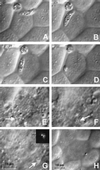Invasion in vitro of mosquito midgut cells by the malaria parasite proceeds by a conserved mechanism and results in death of the invaded midgut cells
- PMID: 11027351
- PMCID: PMC17232
- DOI: 10.1073/pnas.97.21.11516
Invasion in vitro of mosquito midgut cells by the malaria parasite proceeds by a conserved mechanism and results in death of the invaded midgut cells
Abstract
Using an in vitro culture system, we observed the migration of malaria ookinetes on the surface of the mosquito midgut and invasion of the midgut epithelium. Ookinetes display constrictions during migration to the midgut surface and a gliding motion once on the luminal midgut surface. Invasion of a midgut cell always occurs at its lateral apical surface. Invasion is rapid and is often followed by invasion of a neighboring midgut cell by the ookinete. The morphology of the invaded cells changes dramatically after invasion, and invaded cells die rapidly. Midgut cell death is accompanied by activation of a caspase-3-like protease, suggesting cell death is apoptotic. The events occurring during invasion were identical for two different species of Plasmodium and two different genera of mosquitoes; they probably represent a universal mechanism of mosquito midgut penetration by the malaria parasite.
Figures





References
-
- Shortt H E. Trans R Soc Trop Med Hyg. 1948;42:227–230. - PubMed
-
- Stohler H. Acta Trop. 1957;14:302–352. - PubMed
-
- Garnham P C C, Bird R G, Baker J R. Trans R Soc Trop Med Hyg. 1962;56:116–120. - PubMed
-
- Mehlhorn H, Peters W, Haberkorn A. Protistologica. 1980;16:135–154.
-
- Meis J F, Ponnudurai T. Parasitol Res. 1987;73:500–506. - PubMed
Publication types
MeSH terms
LinkOut - more resources
Full Text Sources
Other Literature Sources
Research Materials

